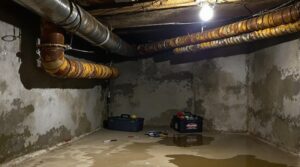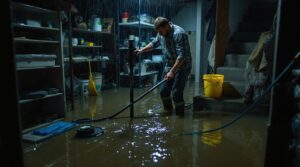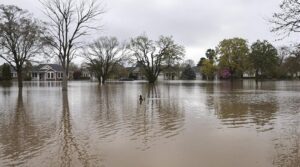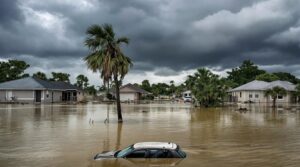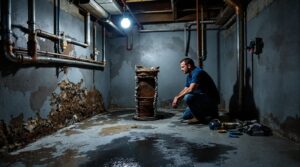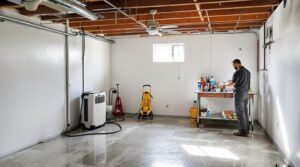After a flood, immediate safety assessment and utility shutoff are critical first steps. Property owners must wait for official clearance before entering and then document all visible damage through photos and videos. Insurance providers should be contacted within 24-48 hours, followed by swift water removal using pumps and dehumidifiers. Professional support from public adjusters can maximize claim settlements while proper documentation and mold prevention protect long-term property value. Understanding the complete recovery process guarantees best results.
Key Takeaways
- Wait for official clearance and shut off all utilities before entering your flooded property to ensure safety.
- Document all visible damage with photos and videos immediately for insurance claims before beginning cleanup.
- Contact your insurance provider within 24-48 hours and maintain detailed records of all communication.
- Remove standing water quickly using pumps or wet vacuums, then begin drying with fans and dehumidifiers.
- Clean and sanitize affected areas within 48 hours to prevent mold growth, discarding materials that cannot be salvaged.
Assess Safety and Secure Your Property
The immediate aftermath of a flood requires a methodical approach to safety assessment and property security. Before entering a flooded property, residents must wait for official clearance from local authorities to guarantee their safety.
The first vital steps involve shutting off all utilities, including electricity, gas, and water supplies, to prevent potential hazards.
Once cleared to enter, individuals should use a working flashlight to assess the property, paying careful attention to water levels near electrical outlets. A detailed inspection of the structure's integrity is essential, looking for signs of warping, cracks, or other damage that could compromise safety.
Property owners should systematically document any visible damage through extensive photos and videos, as this documentation will be significant for insurance claims. These records will provide necessary evidence when working with an insurance adjuster to evaluate the extent of damage and determine appropriate compensation for repairs.
Document All Damage Before Cleanup

Proper documentation of flood damage serves as a critical first step before initiating any cleanup efforts. Homeowners should thoroughly photograph and video record all visible damage, capturing high-resolution images of water-affected items and structural impacts before moving or removing anything from the property.
Creating a detailed timeline is essential for insurance information purposes. Each photo should include a timestamp, and extensive notes should describe the extent of water exposure and specific conditions of damaged items. The documentation process should encompass all affected areas, providing the insurance company with clear evidence of the flood damage's scope and severity.
Maintaining organized digital and physical records streamlines the claims process and supports recovery efforts. Property owners must resist the urge to begin cleanup before completing thorough documentation, as premature removal of damaged items could compromise their insurance claim's validity and potentially reduce coverage benefits.
Contact Insurance and Start Claims Process
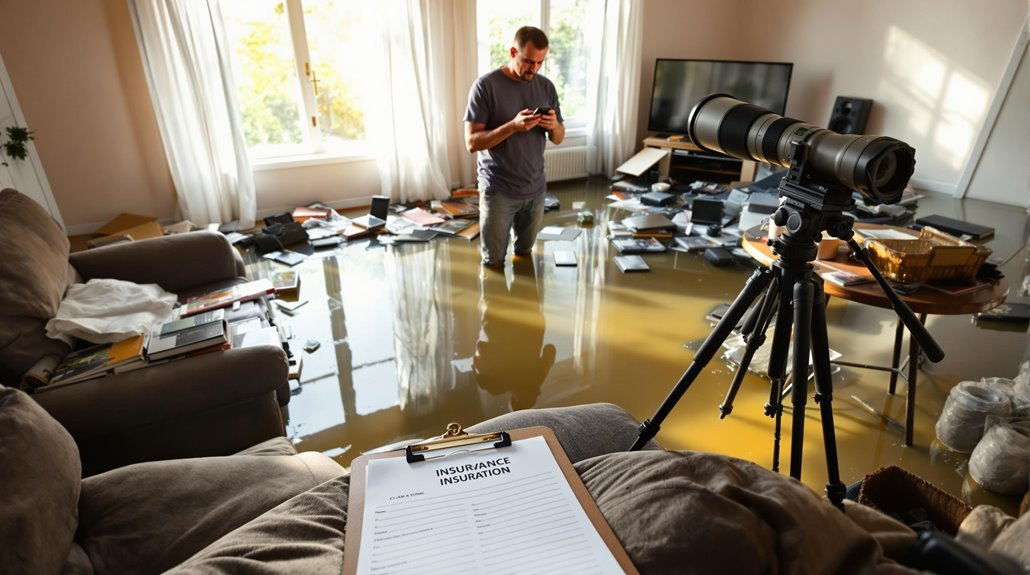
Immediately following flood damage documentation, property owners must contact their insurance provider to initiate the claims process. Insurance companies require prompt notification to guarantee proper handling of flood-related claims and determine coverage specifics.
| Claims Process Steps | Key Requirements |
|---|---|
| Initial Contact | Report damage within 24-48 hours |
| Documentation | Photos, videos, itemized list |
| Coverage Review | Verify flood insurance policy terms |
| Communication Log | Record all interactions with insurer |
Property owners should understand that standard homeowners insurance policies typically do not cover groundwater flood damage. A separate flood insurance policy is necessary for this protection. When filing a claim, individuals must document all damage thoroughly and maintain detailed records of every interaction with their insurer, including dates, names of representatives, and discussion points. Following the insurance company’s specific guidelines for repairs and documentation helps prevent delays in compensation and guarantees a smoother claims process. Property owners should also familiarize themselves with the flood insurance definitions and criteria, as these can vary significantly between policies. Understanding the specific terms and conditions associated with flood insurance can help homeowners select a policy that best meets their needs and covers potential risks in their area. Additionally, regular reviews of one’s coverage are essential, especially after significant life changes or natural events, to ensure adequate protection against future flooding scenarios.
Remove Water and Begin Initial Repairs
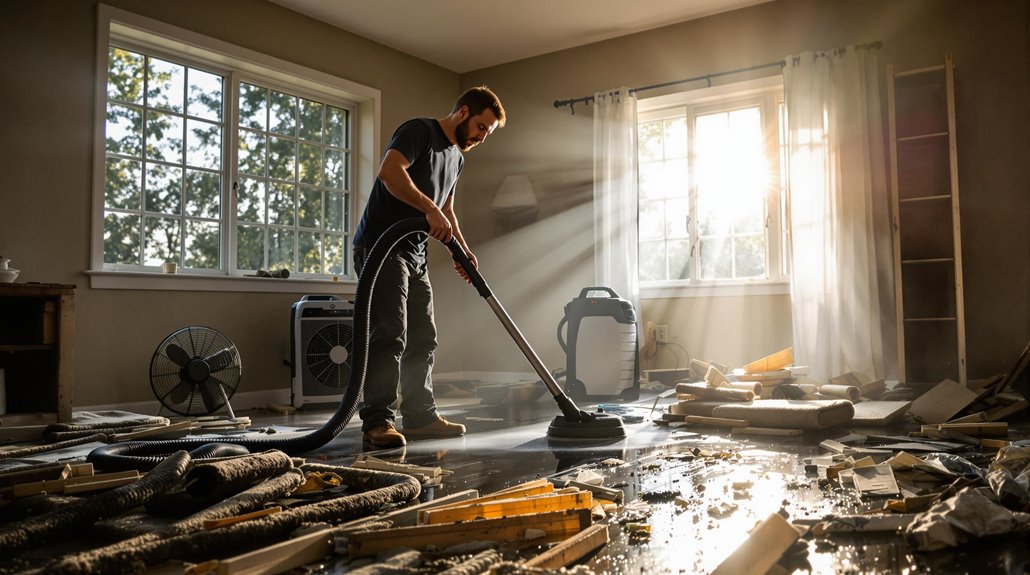
Removing standing water swiftly after a flood represents the most critical step in preventing extensive property damage and health hazards. Homeowners should utilize pumps, wet vacuums, or buckets to remove standing water from affected areas as quickly as possible to minimize structural deterioration and prevent mold growth.
Once water removal is complete, the drying process must begin immediately. Opening windows and doors while operating fans and dehumidifiers helps reduce indoor humidity levels effectively.
Any water-damaged materials, including carpeting, drywall, and insulation, require prompt removal to prevent bacterial contamination and further deterioration. A thorough cleaning and sanitization of all affected surfaces follows, using appropriate cleaning solutions to eliminate potential health risks.
Throughout this process, detailed documentation remains essential for home insurance cover claims. Homeowners should photograph all damage and maintain records of repair work for insurance purposes, ensuring proper compensation for restoration efforts.
Prevent Mold Growth and Long-Term Issues

Since mold can develop within 24 hours of flooding, swift action to remove wet materials and contents from the home is paramount to preventing extensive microbial growth. After removing standing water, thorough cleaning of affected surfaces using a detergent-water mixture, combined with an approved disinfectant, helps eliminate potential mold colonies. Maintaining proper humidity levels below 50% through ventilation and dehumidification is essential for long-term prevention.
| Prevention Step | Action Required | Timeline |
|---|---|---|
| Initial Response | Remove wet materials | Within 24-48 hours |
| Surface Treatment | Clean with detergent solution | Immediately after water removal |
| Humidity Control | Use dehumidifiers and fans | Continuous monitoring |
| Monitoring | Inspect affected areas | Weekly for several weeks |
Items that have sustained significant water damage, particularly porous materials like carpets and mattresses, should be discarded if they cannot be thoroughly cleaned. Regular inspection of previously affected areas, including hidden spaces behind walls and under floors, helps identify and address any emerging mold issues promptly.
The Benefits Of Consulting A Public Adjuster

Consulting a public adjuster after a flood offers distinct advantages through their specialized expertise in insurance claims and ability to provide thorough, objective damage assessments.
Their professional guidance streamlines the complex claims process while ensuring all damage is properly documented and valued according to policy terms.
Studies show that claims handled by public adjusters typically result in considerably higher settlements, with payouts up to 800% more than claims filed without professional representation.
Expertise In Insurance Claims
Maneuvering insurance claims after a flood can be considerably more successful with the expertise of a public adjuster. These professionals possess in-depth knowledge of homeowners policy details and understand how to effectively navigate complex insurance documentation. Their expertise enables accurate damage assessments, often resulting in settlements approximately 20% higher than initial offers from insurance companies.
Public adjusters serve as dedicated insurance representatives working exclusively for the policyholder's interests, not the insurance provider. Their specialized knowledge allows them to identify covered damages that might otherwise be overlooked during flood assessment.
They handle all communications with insurance companies, streamlining the claims process while ensuring thorough documentation. This professional guidance can prove invaluable when interpreting policy language, understanding coverage limitations, and maximizing the potential settlement value of flood-related claims.
Objective Damage Assessment
Objectivity stands as a cornerstone benefit when engaging a public adjuster for flood damage assessment. These professionals bring unbiased expertise to inspect the property, documenting water damage thoroughly and identifying issues that homeowners might overlook, from failed sump pump systems to hidden structural concerns.
Public adjusters methodically evaluate what homeowners insurance cover, ensuring no damage goes unreported. Their systematic approach includes extensive documentation of affected areas, which strengthens the claim's validity.
Working on a contingency basis, they have a vested interest in conducting detailed assessments that capture the full scope of damages. This professional evaluation not only helps maximize claim settlements but also provides homeowners with a clear, factual understanding of their property's condition and the necessary steps for recovery.
Streamlined Claim Process
Professional guidance during flood-related insurance claims greatly streamlines the settlement process and maximizes potential compensation. Public adjusters serve as expert advocates, helping to determine the cause of damage and guarantee thorough documentation. Studies show their involvement typically results in 20% higher settlements compared to unassisted claims.
| Benefit | Public Adjuster Role | Outcome |
|---|---|---|
| Expert Analysis | Interprets policy language | Clear understanding of coverage |
| Documentation | Records all damages | extensive claim support |
| Negotiation | Represents policyholder | Higher settlement potential |
| Time Management | Handles communication | Reduced stress and efficiency |
Since coverage is subject to specific policy terms and conditions, a public adjuster's expertise proves invaluable in maneuvering complex claim requirements. Their professional oversight helps avoid common pitfalls while guaranteeing policyholders receive full compensation for covered losses.
Higher Claim Payouts & Settlements
Most policyholders who work with public adjusters achieve significantly higher claim settlements compared to those filing independently.
Studies indicate settlements can increase by 20% to 50% when utilizing professional adjustment services. Public adjusters enhance claim outcomes through thorough damage documentation and expert policy interpretation.
Key benefits of working with a public adjuster include:
- In-depth assessment of what's covered under the insurance policy, ensuring all eligible damages are identified.
- Professional documentation and evidence gathering to substantiate higher claim payouts.
- Expert negotiation skills that typically result in more favorable settlement offers.
- Time-saving assistance that allows homeowners to focus on recovery while maximizing their claim value.
This professional support proves particularly valuable during flood-related claims, where damage assessment can be complex and extensive.
About The Public Claims Adjusters Network (PCAN)
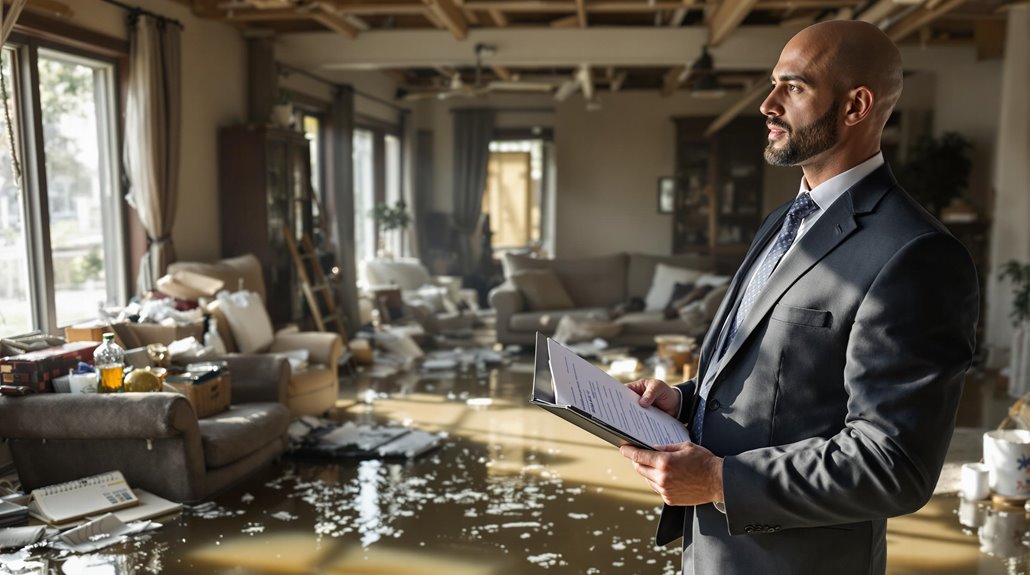
The Public Claims Adjusters Network (PCAN) operates as a nationwide organization of vetted, state-licensed public adjusters who handle residential and commercial property damage insurance claims.
With member adjusters covering over 30 different claim types across 40+ states, PCAN specializes in managing complex cases, including water damage and standing water incidents that require coordination with Emergency Management agencies.
PCAN maintains strict quality standards through a rigorous vetting process for all member adjusters.
Each adjuster must complete an intensive application and interview process before being admitted to the network.
The organization conducts mandatory yearly audits of licenses and reviews any complaints to guarantee members maintain the highest standards of ethics and professionalism.
This systematic approach allows PCAN to serve as a trusted resource for policyholders seeking expert assistance with their insurance claims, connecting them with top-tier public adjusters who have demonstrated expertise in their field.
Frequently Asked Questions
What Should Be Done After the Flood?
Following flood damage assessment, residents should implement proper restoration techniques, take health precautions during cleanup, document damages thoroughly, contact insurance providers for claims, and wait for official safety clearance.
What Do People Do After a Flood?
People assess safety precautions, document damage, initiate rebuilding efforts, seek insurance claims, engage in community support networks, and focus on emotional recovery while restoring their homes and lives.
What Should You Do When Returning Home After It Has Been Flooded?
Surprisingly, taking selfies isn't the first priority. Residents must follow safety precautions, conduct damage assessment, document everything thoroughly, begin cleanup process methodically, while managing the emotional impact of devastation.
What Does FEMA Pay for After a Flood?
FEMA provides disaster assistance for temporary housing, essential home repairs, personal property replacement, and flood insurance premiums. Flood relief covers structural damage, while recovery resources help restore properties to safe, habitable conditions.
Final Thoughts
After a flood, taking systematic action is critical for recovery and protecting your investment. Through proper documentation, prompt insurance claims, and professional guidance, property owners can navigate the complex restoration process effectively. Coincidentally, those who engage public adjusters often secure settlements up to 40% higher than self-managed claims. Following established post-flood protocols while leveraging expert resources remains the most reliable path to successful property rehabilitation.
For homeowners dealing with flood or any other property damage covered by their insurance policy, insurance industry professionals and legal experts strongly advise consulting a qualified state-licensed public adjuster. These licensed professionals work exclusively for policyholders, not insurance companies, serving as dedicated advocates throughout the claims process. Public adjusters specialize in identifying hidden damages often unknown to policyholders, thoroughly documenting losses, and negotiating with insurance companies to ensure fair settlements while protecting policyholder rights.
By engaging a public adjuster, property owners typically maximize their claim payouts, expedite the claims process, and reduce the stress of dealing with insurance companies. Policyholders interested in discussing their property damage claims can request a no-obligation free consultation with a Public Claims Adjusters Network (PCAN) member public adjuster through our contact page.
